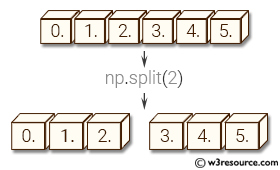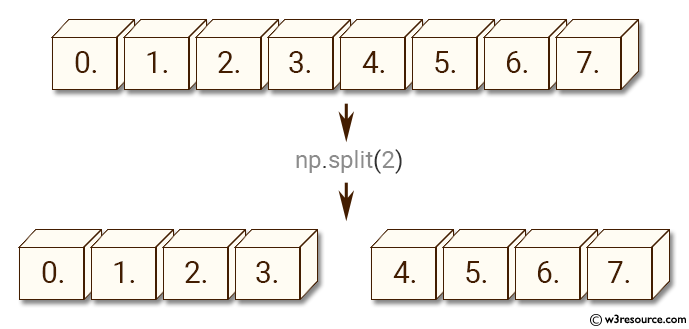NumPy: split() function
numpy.split() function
The split() function is used assemble an nd-array from given nested lists of splits.
Syntax:
numpy.split(ary, indices_or_sections, axis=0)

Version: 1.15.0
Parameter:
| Name | Description | Required / Optional |
|---|---|---|
| ary | Array to be divided into sub-arrays. | Required |
| indices_or_sections | If indices_or_sections is an integer, N, the array will be divided into N equal arrays along axis. If such a split is not possible, an error is raised. If indices_or_sections is a 1-D array of sorted integers, the entries indicate where along axis the array is split. For example, [2, 3] would, for axis=0, result in
|
Required |
| axis | The axis along which to split, default is 0. | Optional |
Return value:
sub-arrays : list of ndarrays A list of sub-arrays.
Raises: ValueError - If indices_or_sections is given as an integer, but a split does not result in equal division.
Example-1: numpy.split() function
>>> import numpy as np
>>> a = np.arange(8.0)
>>> np.split(a, 2)
[array([ 0., 1., 2., 3.]), array([ 4., 5., 6., 7.])]
Pictorial Presentation:

Example-2: numpy.split() function
>>> import numpy as np
>>> a = np.arange(6.0)
>>> np.split(a, [4, 5, 6, 7])
[array([ 0., 1., 2., 3.]), array([ 4.]), array([ 5.]), array([], dtype=float64), array([], dtype=float64)]
Python - NumPy Code Editor:
Previous: block()
Next: array_split()
- New Content published on w3resource:
- HTML-CSS Practical: Exercises, Practice, Solution
- Java Regular Expression: Exercises, Practice, Solution
- Scala Programming Exercises, Practice, Solution
- Python Itertools exercises
- Python Numpy exercises
- Python GeoPy Package exercises
- Python Pandas exercises
- Python nltk exercises
- Python BeautifulSoup exercises
- Form Template
- Composer - PHP Package Manager
- PHPUnit - PHP Testing
- Laravel - PHP Framework
- Angular - JavaScript Framework
- Vue - JavaScript Framework
- Jest - JavaScript Testing Framework
